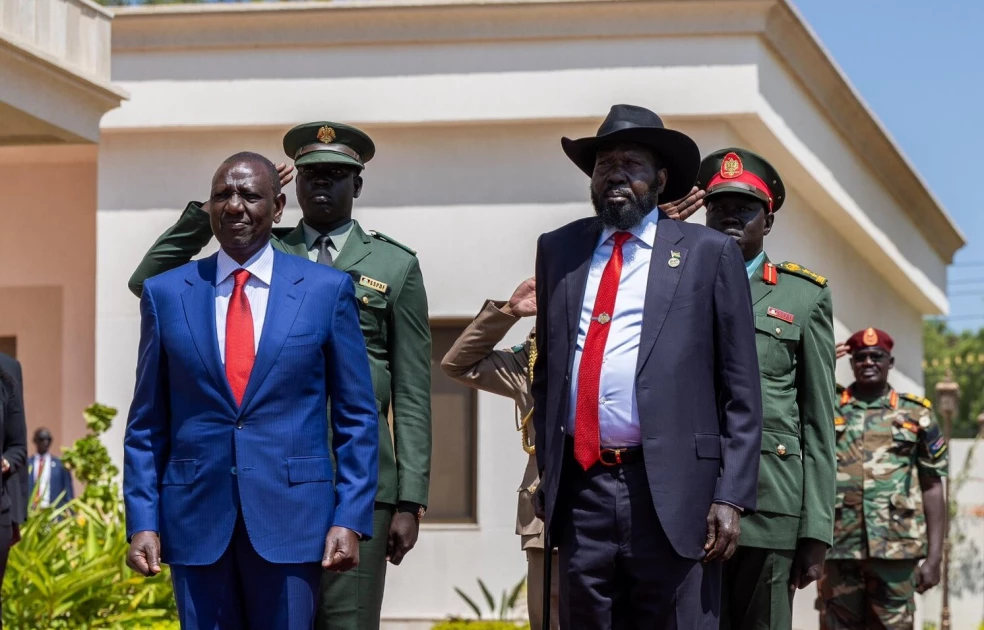In a pivotal moment for South Sudan, President William Ruto of Kenya recently visited Juba to bolster the Tumaini Peace Initiative, a significant diplomatic effort aimed at resolving the nation’s protracted conflicts. Launched in May 2024, the initiative seeks to include holdout groups that have not signed the 2018 Revitalised Agreement on the Resolution of Conflict in South Sudan (R-ARCSS). This ambitious project aims to address the deep-rooted issues that have plagued South Sudan since its independence in 2011.

President William Ruto and his South Sudanese counterpart Salva Kiir in Juba, South Sudan on November 6, 2024. | PHOTO: PCS
The Tumaini Initiative, meaning “hope” in Swahili, was inaugurated with high hopes during a ceremony attended by six heads of state and numerous diplomats in Nairobi. It represents a renewed commitment to peace, aiming to create a comprehensive settlement that includes various factions previously excluded from peace talks. The initiative’s launch was marked by optimism, with many viewing it as a potential turning point for South Sudan’s future.
Recent developments indicate progress within the Tumaini framework. On July 15, 2024, parties involved in the peace process reached an agreement on eight critical protocols concerning security arrangements, ceasefire terms, and humanitarian access. These protocols are designed to address communal violence and the proliferation of arms among civilians, which have been significant contributors to instability in the region. Michael Makuei, South Sudan’s Minister of Information, emphasized the importance of these agreements as foundational steps towards achieving lasting peace.
However, skepticism remains prevalent among various stakeholders. Critics argue that previous peace agreements have often failed due to lack of implementation and commitment from the South Sudanese government. The absence of key opposition figures, such as Thomas Cirillo, who leads a militia stronghold near Uganda’s border, raises concerns about the inclusivity and effectiveness of the initiative. Furthermore, First Vice President Riek Machar has expressed fears that the Tumaini Initiative could undermine existing agreements, particularly the R-ARCSS.
Despite these challenges, the Tumaini Initiative is seen as an opportunity for political reconfiguration in South Sudan. It could potentially allow marginalized political figures like Pagan Amum and Paul Malong to negotiate their return to power. This aspect of the initiative could help stabilize the political landscape by integrating various factions into a more cohesive government structure.
Kenya’s role as a mediator is crucial in this context. By hosting these negotiations, Kenya aims to reaffirm its influence in regional politics while promoting peace and stability in South Sudan. The choice of Major-Gen Lazarus Sumbeiywo as lead mediator signals Kenya’s commitment to facilitating dialogue and fostering trust among conflicting parties. The Kenyan civil society has also shown support for the initiative, urging leaders from both countries to prioritize peace over power struggles.
The upcoming elections in December 2024 add urgency to these discussions. The transitional government in South Sudan views the Tumaini Initiative as essential for generating international goodwill and financial support ahead of these elections. By presenting itself as a peacemaker, President Salva Kiir’s administration hopes to regain favor with international partners who have been critical of its governance.
Moreover, there are calls for comprehensive reforms within South Sudan’s security sector and governance structures. Stakeholders are advocating for transparent management of public resources and accountability measures that could help restore public trust in government institutions. These reforms are seen as vital for ensuring that any peace agreement is sustainable and genuinely benefits the people of South Sudan.
As discussions continue, it is crucial for all parties involved to remain committed to inclusivity and dialogue. The success of the Tumaini Initiative hinges on its ability to bring together diverse voices from across South Sudan’s political spectrum while addressing underlying grievances that have fueled conflict for years.
While there is cautious optimism surrounding the Tumaini Peace Initiative’s potential to reshape South Sudan’s future, significant hurdles remain. The interplay between hope and skepticism will define this process as leaders strive for a lasting resolution to one of Africa’s most challenging conflicts. The world watches closely as South Sudan navigates this critical juncture—one that could either lead to enduring peace or further entrenchment of division and violence.



















